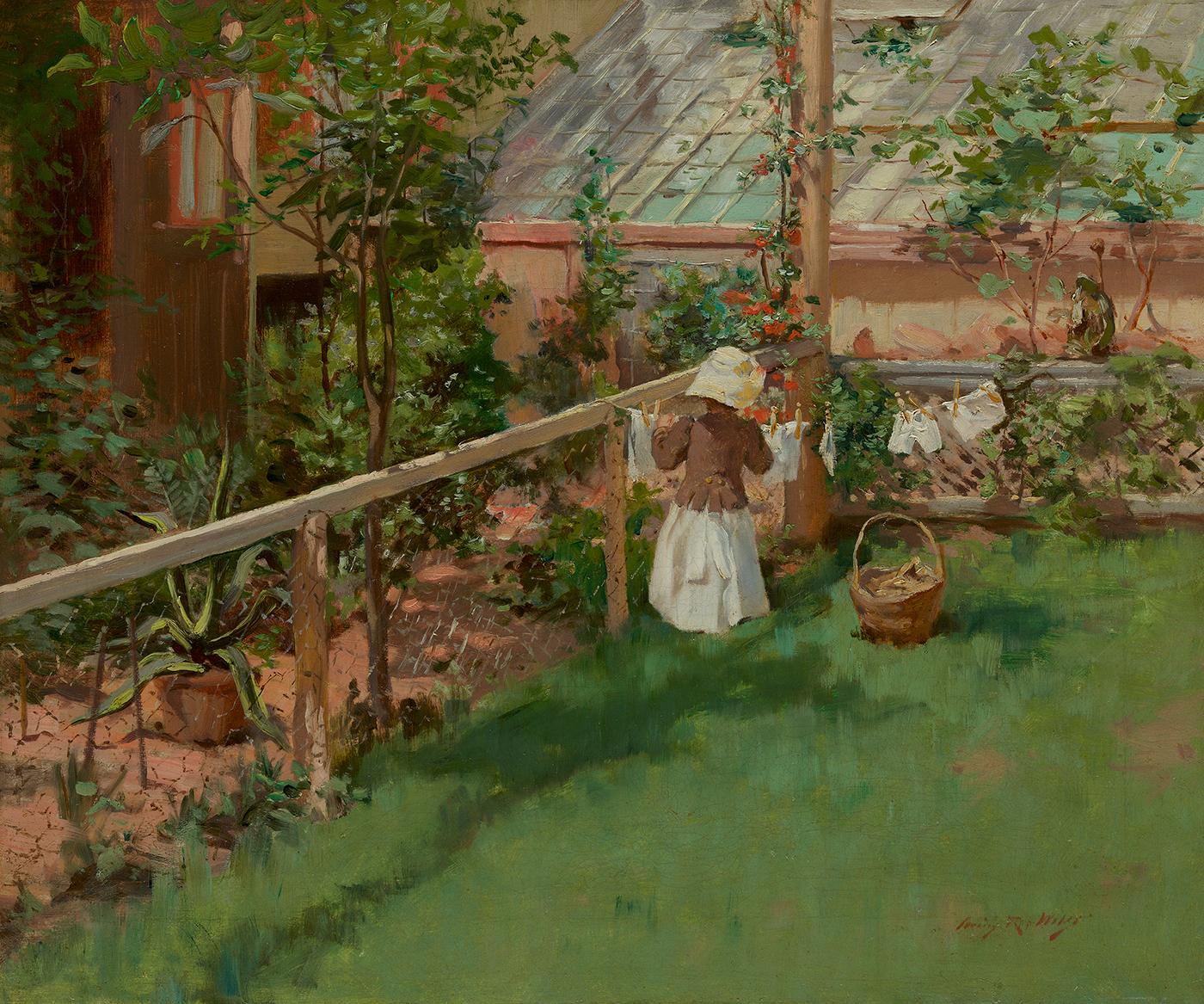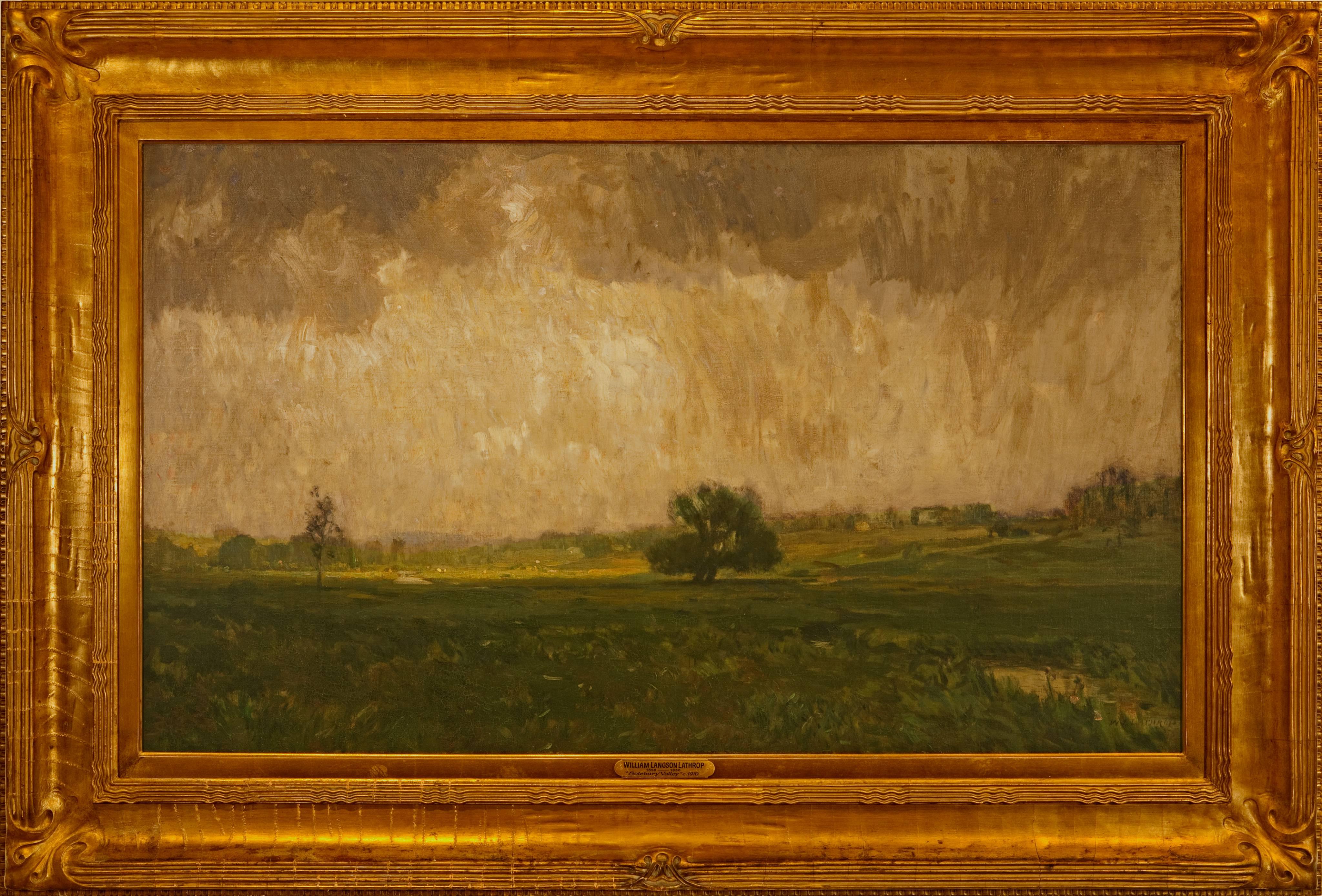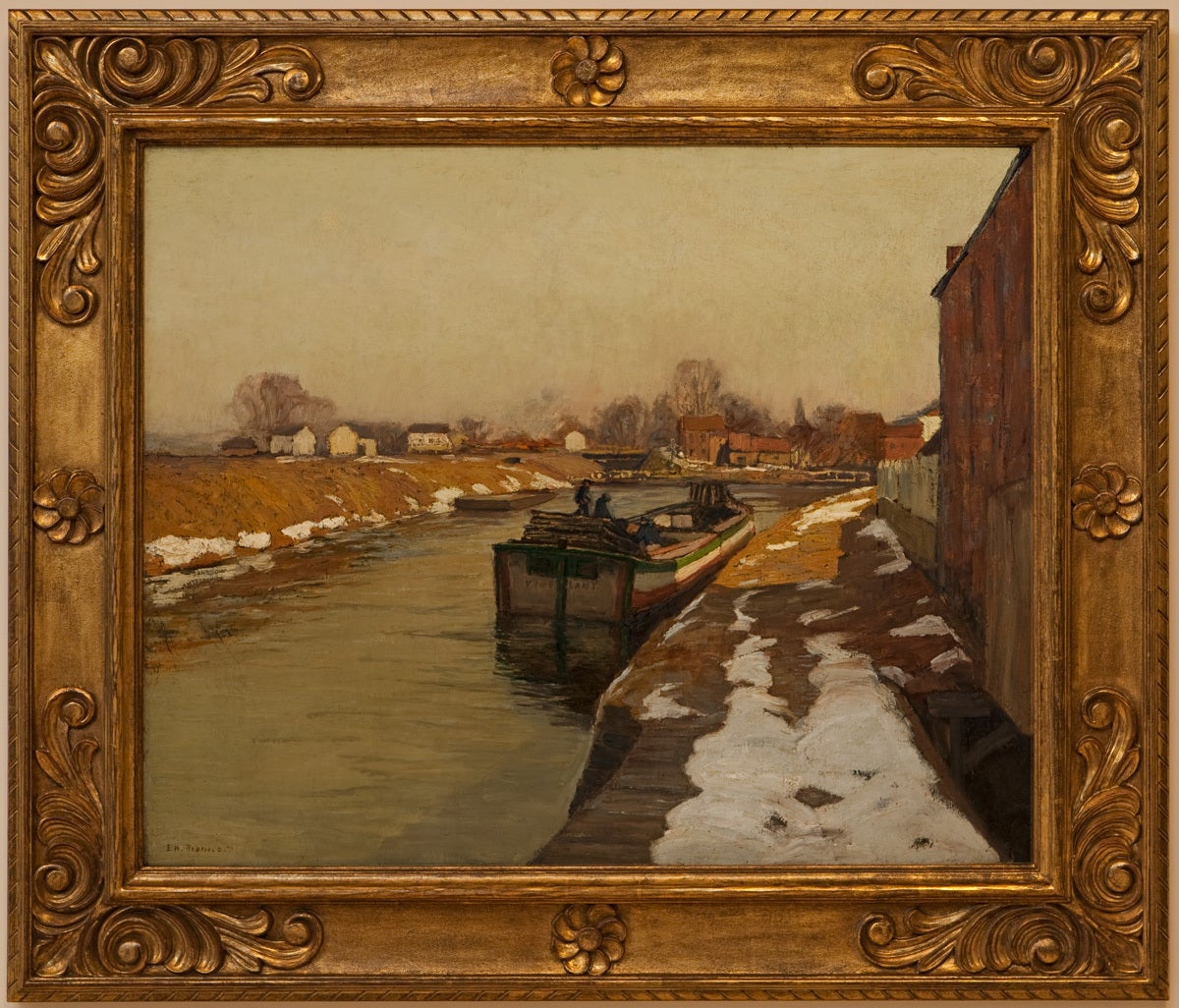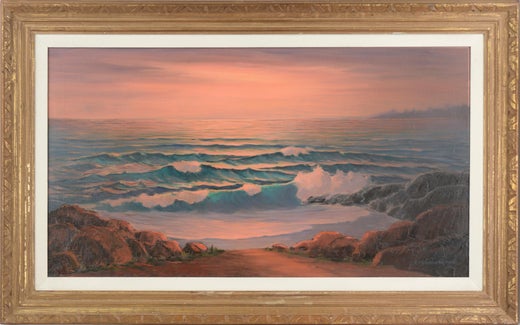Cecil F. ChamberlinMid Century California Coast Landscape with Oak Tree -- "The Last Stand"c.1950
c.1950
About the Item
- Creator:Cecil F. Chamberlin (1899 - 1963, American)
- Creation Year:c.1950
- Dimensions:Height: 23 in (58.42 cm)Width: 27.5 in (69.85 cm)Depth: 1 in (2.54 cm)
- Medium:
- Movement & Style:
- Period:
- Condition:Previously owned and used, with little or no signs of wear and is in good condition. No structural issues.
- Gallery Location:Soquel, CA
- Reference Number:
Cecil F. Chamberlin
Cecil F. Chamberlin was born in Santa Rosa, California in 1899. He was educated at Stanford University and then studied art at the San Francisco Art Institute (SFAI). Chamberlin taught art in San Francisco for many years. During the later part of his life, he lived down the coast in Santa Cruz, where he operated an art gallery, lectured and had many students. He was a nephew of artist Winnie Chamberlin. His work includes seascapes and landscapes of the area around his home. He was also a member of the Santa Cruz Art League and Allied Artists of American Artists Professional League (AAPL), Society of Women Artists (SWA) and Los Gatos Art League.
- ShippingRetrieving quote...Ships From: Soquel, CA
- Return PolicyA return for this item may be initiated within 14 days of delivery.
- Monterey Coastal Mountains LandscapeBy Jack LynnLocated in Soquel, CAGorgeous plein air landscape painting of green fields with California mountains and the coast in the background by Monterey area artist Jack Lynn (American, 20th Century). Unframed. ...Category
1990s American Impressionist Landscape Paintings
MaterialsOil, Canvas
- Mendocino Homestead, Vintage 1970's Northern California LandscapeBy Jon BlanchetteLocated in Soquel, CABeautiful plein air landscape of an old Mendocino country house by listed artist Jon Blanchette (American, 1908-1987). Signed "Jon Blanchette" lower right. Presented in a giltwood ...Category
1970s American Impressionist Landscape Paintings
MaterialsOil, Canvas, Cardboard
- A Winter Scene - Snowy 1930's LandscapeBy Frederick R. WagnerLocated in Soquel, CASerene winter landscape of a snow covered hills with a frozen creek and far off house in the distance by Frederick Wagner (American, 1864-1940), c.1930's. Signed "F. W." lower right....Category
1930s American Impressionist Landscape Paintings
MaterialsCanvas, Oil
- Early 20th Century Mission San Juan Capistrano - Figurative LandscapeBy Warren E. RollinsLocated in Soquel, CAStunning figurative landscape of the Mission San Juan Capistrano by Warren Eliphalet Rollins (American, 1861-1962). Presented in a giltwood frame. "Capistrano" lower right, unsigned. This is a study for a larger painting of the same scene. Image size, 14.5"H x 21"W. For many years Warren Eliphalet Rollins was known as the "Dean of the Santa Fe art colony." He was the first artist to have a formal exhibition there; it was held in 1906 in the old Palace of the Governors. He was a close friend of Carlos Vierra, Gerald Cassidy, Kenneth Chapman, Sheldon Parsons and most of the other famous artists who assembled in the New Mexican capital during the first half of this century. Born in Carson City, Nevada, Rollins was raised in California and attended the San Francisco School of Design where he studied under Virgil Williams. At the completion of his studies, he was awarded the Avery Gold Medal and made Assistant Director of the school. Following his marriage in 1887, he and his wife settled in San Diego, and it was during this period that Rollins became interested in the Indian as subject matter. In search of material, Rollins, his wife, and their two daughters, Ramona and Ruth, traveled through every Western state from the Mexican to the Canadian borders. While in Montana, Rollins painted a portrait of Calamity Jane...Category
1910s American Impressionist Landscape Paintings
MaterialsCanvas, Oil
- Man and His Guitar FigurativeBy Michael William EgglestonLocated in Soquel, CAContemporary oil painting of a man playing his guitar on the front porch by San Francisco artist Michael William Eggleston (American, 20th century). From a collection of his works. M...Category
Early 2000s American Impressionist Figurative Paintings
MaterialsCanvas, Oil
- Stowe Vermont Village Sleigh Ride, Mid Century Winter Figurative LandscapeBy Walter Thomas SacksLocated in Soquel, CAStowe Vermont Village Sleigh Ride - Mid Century Winter Figurative Landscape A bright, crisp morning and a sleigh ride through new snow in Stowe, Vermont...Category
1940s American Impressionist Landscape Paintings
MaterialsCanvas, Oil
- At the ClotheslineBy Irving Ramsey WilesLocated in New York, NYSigned lower right: Irving R. WilesCategory
Late 19th Century American Impressionist Landscape Paintings
MaterialsCanvas, Oil
- "Alley Fiends"By John R. GrabachLocated in Lambertville, NJJim’s of Lambertville is proud to offer this artwork by: John R. Grabach (1886 - 1981) John Grabach was a highly regarded New Jersey artist, teacher, and author of the classic text...Category
1930s American Impressionist Landscape Paintings
MaterialsCanvas, Oil
- "Forest Strongholds"By John F. CarlsonLocated in Lambertville, NJSigned lower right. Complemented by a hand carved and gilt frame. Exhibited at the National Academy of Design, 1928Category
20th Century American Impressionist Landscape Paintings
MaterialsCanvas, Oil
- "Solebury Valley"By William Langson LathropLocated in Lambertville, NJSigned lower right. Complemented by a period frame. William L. Lathrop (1859-1938) Deemed “Father of the New Hope Art Colony”, William Langson Lathrop was born in Warren, Illinois. He was largely self-taught, having only studied briefly with William Merritt Chase in 1887, at the Art Students League. Lathrop first moved east in the early 1880s, and took a job at the Photoengraving Company in New York City. While there, he befriended a fellow employee, Henry B. Snell. The two men became lifelong friends and ultimately, both would be considered central figures among the New Hope Art Colony. Lathrop's early years as an artist were ones of continuing struggle. His efforts to break through in the New York art scene seemed futile, so he scraped enough money together to travel to Europe with Henry Snell in1888. There he met and married an English girl, Annie Burt. Upon returning to New York, he tried his hand at etching, making tools from old saw blades...Category
1910s American Impressionist Landscape Paintings
MaterialsCanvas, Oil
- Winter MoonlightBy George William SotterLocated in Lambertville, NJsigned lower rightCategory
1910s American Impressionist Landscape Paintings
MaterialsCanvas, Oil
- "The Canal"By Edward Willis RedfieldLocated in Lambertville, NJJim’s of Lambertville is proud to offer this artwork. Signed lower left. Complemented by a hand carved and gilt frame. Illustrated in "Edward Redfield: Just Values and Fine Seeing" by Constance Kimmerle and the Pennsylvania Academy of the Fine Arts's Exhibition of Paintings by Edward Redfield (April 17 to May 16, 1909) brochure Edward Willis Redfield (1869 - 1965) Edward W. Redfield was born in Bridgeville, Delaware, moving to Philadelphia as a young child. Determined to be an artist from an early age, he studied at the Spring Garden Institute and the Franklin Institute before entering the Pennsylvania Academy from 1887 to 1889, where he studied under Thomas Anshutz, James Kelly, and Thomas Hovenden. Along with his friend and fellow artist, Robert Henri, he traveled abroad in 1889 and studied at the Academie Julian in Paris under William Bouguereau and Tony Robert-Fleury. While in France, Redfield met Elise Deligant, the daughter of an innkeeper, and married in London in 1893. Upon his return to the United States, Redfield and his wife settled in Glenside, Pennsylvania. He remained there until 1898, at which time he moved his family to Center Bridge, a town several miles north of New Hope along the Delaware River. Redfield painted prolifically in the 1890s but it was not until the beginning of the twentieth century that he would develop the bold impressionist style that defined his career. As Redfield’s international reputation spread, many young artists gravitated to New Hope as he was a great inspiration and an iconic role model. Edward Redfield remained in Center Bridge throughout his long life, fathering his six children there. Around 1905 and 1906, Redfield’s style was coming into its own, employing thick vigorous brush strokes tightly woven and layered with a multitude of colors. These large plein-air canvases define the essence of Pennsylvania Impressionism. By 1907, Redfield had perfected his craft and, from this point forward, was creating some of his finest work. Redfield would once again return to France where he painted a small but important body of work between 1907 and 1908. While there, he received an Honorable Mention from the Paris Salon for one of these canvases. In 1910 he was awarded a Gold Medal at the prestigious Buenos Aires Exposition and at the Panama-Pacific Exposition of 1915 in San Francisco, an entire gallery was dedicated for twenty-one of his paintings. Since Redfield painted for Exhibition with the intent to win medals, his best effort often went into his larger paintings. Although he also painted many fine smaller pictures, virtually all of his works were of major award-winning canvas sizes of 38x50 or 50x56 inches. If one were to assign a period of Redfield’s work that was representative of his “best period”, it would have to be from 1907 to 1925. Although he was capable of creating masterpieces though the late 1940s, his style fully matured by 1907 and most work from then through the early twenties was of consistently high quality. In the later 1920s and through the 1930s and 1940s, he was like most other great artists, creating some paintings that were superb examples and others that were of more ordinary quality. Redfield earned an international reputation at a young age, known for accurately recording nature with his canvases and painting virtually all of his work outdoors; Redfield was one of a rare breed. He was regarded as the pioneer of impressionist winter landscape painting in America, having few if any equals. Redfield spent summers in Maine, first at Boothbay Harbor and beginning in the 1920s, on Monhegan Island. There he painted colorful marine and coastal scenes as well as the island’s landscape and fishing shacks. He remained active painting and making Windsor style furniture...Category
Early 1900s American Impressionist Landscape Paintings
MaterialsCanvas, Oil






